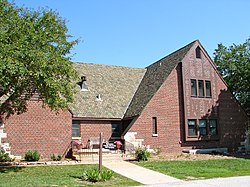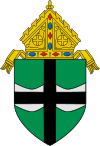| Formation | December 12, 1917; 107 years ago (1917-12-12) |
|---|---|
| Founder | Edward J. Flanagan |
| Founded at | Boys Town, Nebraska |
| Type | 501(c)(3) nonprofit |
| Headquarters | Boys Town, Nebraska |
| Website | www |
Boys Town, officially Father Flanagan's Boys' Home, is a non-profit organization based in Boys Town, Nebraska, dedicated to caring for children and families.
History

Boys Town was founded on December 12, 1917, as an orphanage for boys. Originally known as "The City of Little Men", the organization was begun by Edward J. Flanagan, a Roman Catholic priest, while he worked in the Diocese of Omaha. Using a loan of $90, he first rented a home at 25th and Dodge streets, in Omaha, to care for five boys. From these beginnings, the City of Little Men developed new juvenile care methods in 20th-century America, emphasizing "social preparation as a model for public boys' homes worldwide". Flanagan is now a candidate for beatification.
1917–1921: Early growth and move to Overlook Farm
Boys Town quickly grew from the original five boys living in a home in downtown Omaha in 1917 to more than 100 boys by early 1918. The increase required a relocation in 1919 to South Omaha. Flanagan had been contending with criticism about having kids of different races, religions, nationalities, and backgrounds all living together under the same roof. Mounting societal tensions and the need for even more space led to Flanagan’s 1921 decision to relocate Boys Town to Overlook Farm.
In 1921, Father Flanagan purchased Overlook Farm on the outskirts of Omaha and moved his boys' home there. The move to Overlook Farm was a major step in Father Flanagan's plan to create a developed community. In time, the Home became known as the Village of Boys Town. By the 1930s, hundreds of boys lived at the Village, which was developed to include a school, dormitories, and administration buildings. Adapting the "Junior Republic" model, the boys elected their own government, including a mayor, council, and commissioners. In 1936, the community of Boys Town was designated as an official village in the state of Nebraska.
By the late 1930s, Boys Town's development and staff efforts to court public support had made it the subject of many newspaper and magazine articles. In 1938, producers from MGM Studios traveled to Boys Town to discuss the prospects of a movie about the Home. A few months later, Spencer Tracy and Mickey Rooney, two of the biggest stars of the day, and a 61-member crew arrived at Boys Town to begin ten days of on-location filming. Tracy won an Academy Award for his role.
In 1943, Boys Town adopted as its image and logo a picture of a boy carrying a younger boy on his back, captioned "He Ain't Heavy, He's My Brother," a phrase originating with the United Free Church of Scotland.
When Flanagan suffered a fatal heart attack in Berlin, Germany in 1948, the archbishop of Omaha, Gerald T. Bergan, named Monsignor Nicholas H. Wegner as Boys Town's second executive director. The best records available indicate that the home's population peaked at 880, in the 1960s.
Fundraising controversy and Wegner's resignation
Boys Town's fundraising practices drew scrutiny in 1972 after the Omaha Sun, a local newspaper, investigated the nonprofit after a tip from local Omaha businessman Warren Buffett. The charity was found to have an endowment of over $191 million in 1971, enough to place it at #230 on the Fortune 500, yet continued to fundraise even with a shrinking population and no new expansion projects. Wegner was forced to resign and temporarily halted its fundraising activities. The Omaha Sun received the Pulitzer Prize for Local Investigative Specialized Reporting in 1973 for the story. On October 11, 1973, Robert P. Hupp was named the third national executive director.
Transition to Family Home programs
In late 1974, Boys Town hired its first "Family-Teachers", a married couple who would begin caring for a small group of youth in a former cottage being converted into a "Family Home". Three other couples were hired soon after. That core group worked with other staff members to develop formal training materials for the Family-Teachers who were being recruited. As new couples were trained, they moved into newly built homes and converted cottages. By the end of 1975, the last of the dormitories was closed and the transition to the Boys Town Family Home Program was complete.
Boys Town admits girls (1979)
The executive director Robert Hupp had experience working with troubled girls. He had served from 1946 to 1950 as chaplain, teacher, and athletic coach for a girls' home run by the Sisters of the Good Shepherd Convent in Omaha. In 1979, a few girls were admitted to live in a Family Home on the main campus. More followed and by 1985, twenty-six girls were citizens of Boys Town.
National Historic Landmark
United States historic place| Father Flanagan's Boys' Home | |
| U.S. National Register of Historic Places | |
| U.S. National Historic Landmark District | |
 | |
  | |
| Location | Boys Town, Nebraska |
|---|---|
| Coordinates | 41°15′52″N 96°7′58″W / 41.26444°N 96.13278°W / 41.26444; -96.13278 |
| Area | 1,310 acres (5.3 km) |
| Built | 1917 |
| Architect | Leo A. Daly Construction |
| Architectural style | Tudor Revival |
| NRHP reference No. | 85002439 |
| Significant dates | |
| Added to NRHP | February 4, 1985 |
| Designated NHLD | February 4, 1985 |
The national headquarters of Boys Town is in the village of Boys Town, Nebraska, which was listed on the National Register of Historic Places, and was designated a National Historic Landmark, on February 4, 1985.
Facilities include the Hall of History, dedicated to the history of Boys Town; the restored home of Father Flanagan; the Dowd Memorial Chapel and the Chambers Protestant Chapel; and the Leon Myers Stamp Center. The latter provides historical stamp-collecting exhibits and sells donated stamps to provide support for Boys Town programs.
It has a summer camp on West Lake Okoboji, located near West Okoboji, Iowa.

Hospitals and clinics
In 1977, Boys Town founded and continues to operate the Boys Town National Research Hospital, located at 555 N. 30th Street in Omaha. Its sister hospital, Boys Town National Research Hospital – West, is operated on the Boys Town campus. The NPO also operates several medical clinics in Nebraska, and one in Iowa.
National locations
Boys Town has nine sites across the United States, in Central Florida, North Florida, South Florida, Louisiana, Nebraska, Iowa, New England, Nevada, and Washington, D.C.
External links
- Official website
- Case studies of Boys Town, Mackinac Center for Public Policy
- "Nebraska: Boys Town Bonanza", Time, April 10, 1972.
- "Education: Rebuilding Boys Town", Time, August 5, 1974.
- Durham Museum Boys Town exhibit
References
- "Boys Town Centennial Commemorative Coin Program". usmint.gov. September 19, 2016. Retrieved January 8, 2020.
- Timeline
- Colverd, Sue; Hodgkin, Bernard (2011). Developing Emotional Intelligence in the Primary School. Routledge. p. 153. ISBN 978-1136841347. Retrieved July 4, 2016.
- "The Life, Legacy and Canonization Cause of Boys Town Founder Father Edward Flanagan". NCR. October 17, 2021. Retrieved November 28, 2024.
- Cordes, Henry J. (March 2, 2024). "When Segregation Prevailed In US Boys Town May Have Been Nations First Integration Community". Omaha World Herald. Archived from the original on March 2, 2024. Retrieved March 27, 2024.
- Light, Jennifer S. (July 14, 2020). States of Childhood: From the Junior Republic to the American Republic, 1895-1945. p. 214. ISBN 978-0-262-35860-6.
- "Father Edward Flanagan's legacy". www.thebostonpilot.com. Retrieved November 28, 2024.
- Quart, Leonard (1995). "A Second Look: Boys Town". Cinéaste. 21 (3): 55–57. ISSN 0009-7004.
- Williams, Andy (July 13, 2015). "He Ain't Heavy Boys Town's Chris and Lori Mathsen". Omaha Magazine. Archived from the original on August 29, 2016. Retrieved July 4, 2016.
- "Msgr. Flanagan dies suddenly in Berlin". Stars and Stripes. Retrieved April 26, 2021.
- Wegner, Nicholas H. (2005). The mission continues : Monsignor Nicholas Wegner of Boys Town. Barbara Lonnborg; Thomas J. Lynch. Boys Town, Neb.: Boys Town Press. ISBN 1889322636. OCLC 63178368.
- Kneeland, Douglas E. (April 16, 1974). "Boys Town Has an Embarrassment of Riches". The New York Times. Retrieved January 31, 2022.
- Wooster, Martin Morse (October 31, 2017). "Like many nonprofits, their mission started to drift". Philanthropy Daily. Retrieved January 31, 2022.
- Wooster, Martin Morse (November 2, 2011). "Warren Buffett: A Wealthy Philanthropist with Some Bad Ideas". Capital Research Center. Retrieved January 31, 2022.
- The Pulitzer Prizes. "The 1973 Pulitzer Prize Winner". www.pulitzer.org. Retrieved September 29, 2020.
- Lynch, Thomas J. (2016). A century of service, a history of healing: the Boys Town story. Terry Hyland. Virginia Beach, VA. ISBN 978-1681840536. OCLC 950901737.
{{cite book}}: CS1 maint: location missing publisher (link) - "Program Profile: Boys Town Family Home Program". National Institute of Justice, Crime Solutions. January 28, 2015. Retrieved November 28, 2024.
- Martin, Douglas (September 8, 2003). "Monsignor Robert Hupp, 88, Reformer of Boys Town, Dies". New York Times News. Retrieved November 28, 2024.
- "National Register Information System". National Register of Historic Places. National Park Service. January 23, 2007.
- "Father Flanagan's Boys' Home". National Historic Landmark summary listing. National Park Service. Archived from the original on March 11, 2009. Retrieved June 27, 2008.
- "Visit the Village". boystown.org. Retrieved July 4, 2016.
- Rood, Lee. "Major findings of investigation into alleged sex abuse at Boys Town, fundraising approach". The Des Moines Register. Retrieved November 28, 2024.
- "Our Locations". www.boystownhospital.org. Retrieved November 28, 2024.
- "Boys Town National Locations". Retrieved May 8, 2019.
| Landmark cultural venues in Omaha | |
|---|---|
| National Register of Historic Places | |
| National Register of Historic Places and Omaha Landmark | |
| Omaha Landmark | |
| National Historic Landmark | |
- 1917 establishments in the United States
- Organizations established in 1917
- Charities based in Nebraska
- Social welfare charities based in the United States
- Orphanages in the United States
- National Historic Landmarks in Nebraska
- National Register of Historic Places in Omaha, Nebraska
- History of Omaha, Nebraska by community area
- Buildings and structures in Nebraska
- Museums in Omaha, Nebraska
- Philatelic museums in the United States
- Historic house museums in Nebraska
- History museums in Nebraska
- Historic districts on the National Register of Historic Places in Nebraska
